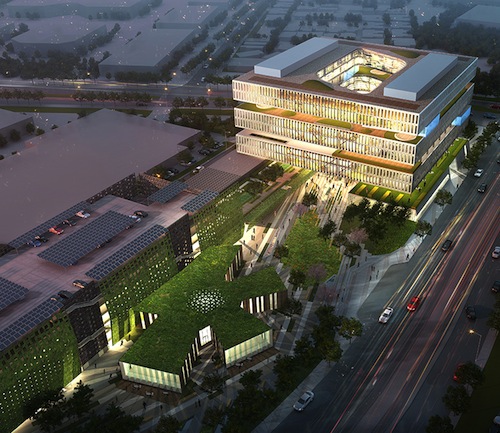Samsung Electronics will enter the Silicon Valley rivalry for best technology-oriented campus with its new headquarters design. The 1.1 million-sf San Jose campus, calculated to give Apple, Facebook and other local high-tech firms a run for their architectural money, will support at least 2,500 sales and R&D staff in Samsung's semiconductor and display businesses.
A pair of linked, 10-story office buildings, encompassing a combined 680,000 sf, will be the hallmark structure. Extensive "green floors" will be provided on every third story, creating a stack of alternating enclosed and open spaces. The gardens will be available to employees for informal breaks and organized recreation. Adjacent facilities will be connected by elevated walkways.
In addition to offices, the program includes research space, a cleanroom, a data center, basketball and sports courts, and cafés in a star-shaped amenities building. A parking structure for more than 1,500 vehicles will feature a rooftop solar array. NBBJ, also the architect behind the recently announced Google Bay View campus, is helming the project.
Samsung Information Systems America is getting new quarters as well. The company has signed a 15-year lease for two six-story buildings in Mountain View's Cypress Business Park, comprising about 385,000 sf.
The state of California is providing an R&D tax credit and an unspecified reimbursement for employee training. The city of San Jose is pitching in with a reduction of traffic impact fees (by more than 50%), a 75%+ reduction in construction taxes, a 50% rebate of up to half of utility taxes for 10 years, and a direct $500,000 economic incentive.
(http://articles.latimes.com/2013/feb/18/business/la-fi-samsung-silicon-valley-20130218)
Related Stories
Museums | Jun 6, 2023
New wing of Natural History Museums of Los Angeles to be a destination and portal
NHM Commons, a new wing and community hub under construction at The Natural History Museums (NHM) of Los Angeles County, was designed to be both a destination and a portal into the building and to the surrounding grounds.
Performing Arts Centers | Jun 6, 2023
Mumbai, India’s new Nita Mukesh Ambani Cultural Centre has three performing arts venues
In Mumbai, India, the recently completed Nita Mukesh Ambani Cultural Centre (NMACC) will showcase music, theater, and fine arts from India and from across the globe. Atlanta’s TVS Design served as the principal architect and interior designer of both the cultural center and the larger, adjacent Jio World Centre.
Architects | Jun 6, 2023
Taking storytelling to a new level in building design, with Gensler's Bob Weis and Andy Cohen
Bob Weis, formerly the head of Disney Imagineering, was recently hired by Gensler as its Global Immersive Experience Design Leader. He joins the firm's co-CEO Andy Cohen to discuss how Gensler will focus on storytelling to connect people to its projects.
Codes and Standards | Jun 6, 2023
California’s new power grid modernization plan furthers ambitious climate goals
California’s new $7.3 billion grid modernization plan is a crucial step in furthering its ambitious climate goals. The board of governors for the California Independent System Operator (CAISO), the state’s grid operator, recently approved a strategy to build thousands of miles of new high-voltage transmission lines.
Mixed-Use | Jun 6, 2023
Public-private partnerships crucial to central business district revitalization
Central Business Districts are under pressure to keep themselves relevant as they face competition from new, vibrant mixed-use neighborhoods emerging across the world’s largest cities.
Multifamily Housing | Jun 6, 2023
Minnesota expected to adopt building code that would cut energy use by 80%
Minnesota Gov. Tim Walz is expected to soon sign a bill that would change the state’s commercial building code so that new structures would use 80% less energy when compared to a 2004 baseline standard. The legislation aims for full implementation of the new code by 2036.
Healthcare Facilities | Jun 5, 2023
Modernizing mental health care in emergency departments: Improving patient outcomes
In today’s mental health crisis, there is a widespread shortage of beds to handle certain populations. Patients may languish in the ED for hours or days before they can be linked to an appropriate inpatient program.
Student Housing | Jun 5, 2023
The power of student engagement: How on-campus student housing can increase enrollment
Studies have confirmed that students are more likely to graduate when they live on campus, particularly when the on-campus experience encourages student learning and engagement, writes Design Collaborative's Nathan Woods, AIA.
Engineers | Jun 5, 2023
How to properly assess structural wind damage
Properly assessing wind damage can identify vulnerabilities in a building's design or construction, which could lead to future damage or loss, writes Matt Wagner, SE, Principal and Managing Director with Walter P Moore.
Cladding and Facade Systems | Jun 5, 2023
27 important questions about façade leakage
Walter P Moore’s Darek Brandt discusses the key questions building owners and property managers should be asking to determine the health of their building's façade.

















